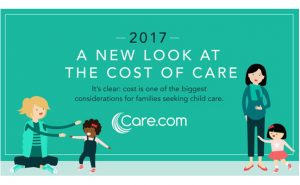 Per an extensive press release, since 2013, Care.com’s Cost of Care Survey has culled insights from more than 1,000 parents nationwide about their child care spending habits, including the rising costs of babysitters, day cares, and nannies. According to the study, 32 percent report spending 20 percent or more of their annual household income on child care.
Per an extensive press release, since 2013, Care.com’s Cost of Care Survey has culled insights from more than 1,000 parents nationwide about their child care spending habits, including the rising costs of babysitters, day cares, and nannies. According to the study, 32 percent report spending 20 percent or more of their annual household income on child care.
Among this year’s findings:
- 40 percent of parents say child care costs have caused tension in their relationship.
- 20 percent of families say they had fewer children than they would have liked because of the high cost of child care.
- Nearly one in three parents would put themselves in debt (or even further in the hole) to pay for child care, up from 25 percent in 2016.
- 72 percent of parents budget for child care, yet 30 percent aren’t able to stay within their monthly budget.
- Nearly two out of three parents (63 percent) say that child care costs influenced their career decisions; 33 percent changed jobs; 27 percent asked for a more flexible work schedule; and 23 percent downshifted to a part-time schedule, or became a stay-at-home parent, to save money on child care.
- 73 percent of working parents say their job has been affected because of child care plans falling through at the last minute, with 64 percent having to use sick days and 54 percent being late to work as a result.
- 85 percent of working parents wish their employer offered child care benefits.
- 68 percent of families say the current tax deduction they receive from the Dependent Care FSA isn’t enough to have a meaningful impact on their child care costs.
Influencing career choices
Prior to having children, approximately three out of four people (76 percent) said that they didn’t think child care costs would influence their career decisions. Yet, nearly two out of three parents (63 percent) stated that child care costs did indeed influence their career. Here’s how:
- 33 percent changed jobs to increase take-home pay;
- 27 percent asked for a more flexible work schedule; and
- 23 percent downshifting to a part-time schedule or becoming a stay-at-home parent to save money on child care.
- Approximately one in four parents (26 percent) who decided to downshift to part-time work or leave the workforce entirely walked away from annual incomes of $50,000 or more.
- In hindsight, approximately one in five parents (21 percent) said that they wouldn’t have made the same career decisions.
Employer support
Nearly half of working parents (44 percent) say their employer seems to care about their child care needs, yet the need for employer support is real.
An overwhelming majority of working parents (85 percent) wish their employer offered child care benefits, such as discounted child care and access to backup child care. This type of support would be meaningful for both parents and employers, as nearly three in four working parents (73 percent) say their job has been affected because their child care plans fell through last-minute. The use of a sick day (64 percent) and being late to work (54 percent) were the Top 2 ways their job was affected.
Care.com has even more data about this study here. But readers, we’re interested in what pest management companies are doing when it comes to the child care needs of their employees. Are you offering flexible hours, work-from-home options for office staff, or even direct child care options — from having a playpen in the office to offering a discounted rate to a local nursery? Or has your workplace not been affected by the child care needs of employees? Please sound off below, or email me at hgooch@northcoastmedia.net.
Leave A Comment